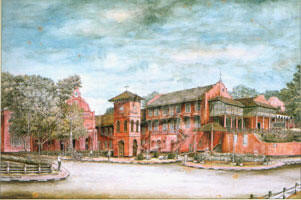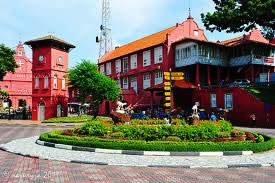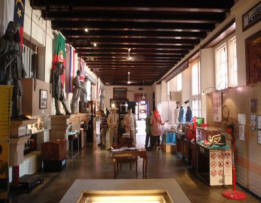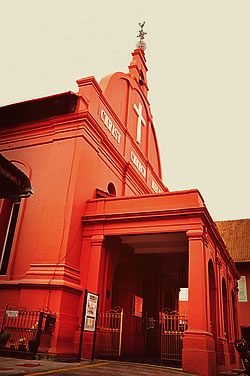Malacca ~ Stadhuys & Christ Church
KL Visitors Guide
HOME >
VISITORS
GUIDE >
PLACES TO
VISIT >
DAY TRIPS OUT
OF KL > MELAKA
>
STADHUYS & CHRIST CHURCH
The
historical Stadthuys dominates Malacca's renowned Dutch Square, or also
known as the Red Square because of the crimson coloured old buildings there.
Also located at the Square is Christ Church, the former Dutch Reformed
Church of Malacca, where the pious Dutch people of the town had long before
often congregated.
 Stadhuys
Stadhuys
The Stadthuy''s (an old Dutch spelling, meaning city hall) built between
1641 and 1660 was the official residence of Dutch Governors and their
officers.
An example of Dutch
architecture, The building once a centre of the Dutch administration in
Melaka, housed the secretary's office, one detached bakery, courtyard,
warehouse and a prison. In its heydays, the Stadthuy's
was situated within the walls of Malacca fort.
The Stadthuy's of Malacca is actually a reproduction of the former Stadhuis
(town hall) of the Frisian town of Hoorn in the Netherlands. However, the
former 'Stadhuis' of Hoorn only existed from 1420 until 1796. It Displays all
the typical features of Dutch colonial architecture, including substantial
solid doors and louvered windows. The edifice is supposedly the oldest remaining
Dutch historical building in the Orient. There are also tales of secret
pathways and tunnels that were suppose to serve as strategic hidden entry
and exit points in the building.
 Situated
at Laksamana Road, beside the Christ Church, the port-red theme extends to
the other buildings around the Town Square and the old clock tower. The old
Melaka Clock Tower also an important landmark in Melaka, was constructed
during the Dutch occupation of Melaka sometime after 1641.
Situated
at Laksamana Road, beside the Christ Church, the port-red theme extends to
the other buildings around the Town Square and the old clock tower. The old
Melaka Clock Tower also an important landmark in Melaka, was constructed
during the Dutch occupation of Melaka sometime after 1641.
During the Dutch rule of
Malacca, the Stadthuys, like all the other Dutch administration buildings in
Southeast Asia, was painted white. When the town became a British colony,
the British in 1911, decided to paint the Stadthuys and the Christ Church a
salmon red. The actual reasons as to why these buildings were painted red by
the British is now lost in time but legends and theories are abundant.
A more plausible reason given was maybe due to the lack of maintenance, the
red laterite stone used to build the Stadthuys showed through the
whitewashed plastering. Also, perhaps heavy tropical rain often splashed the
red soil up the white walls. So, the British decided to paint it all red to
save maintenance costs. Whatever, so red it stayed.
 The
building now houses the History and Ethnography Museum. On display are fine
traditional bridal costumes and relics which will take a couple of hours to
read your way through the detailed explanations of Melaka's past - The
Museum of Ethnography endeavours to exhibit, but in a rather dry and
lifeless manner, the various cultures of the multiethnic people of the town.
The
building now houses the History and Ethnography Museum. On display are fine
traditional bridal costumes and relics which will take a couple of hours to
read your way through the detailed explanations of Melaka's past - The
Museum of Ethnography endeavours to exhibit, but in a rather dry and
lifeless manner, the various cultures of the multiethnic people of the town.
There are showcases on the Malays, Chinese, Indians, the Sino-Malay
Peranakan and even the Portuguese Eurasians. Ironically, the Dutch Eurasians
of Malacca whose very own ancestors once treaded those old hallways, are
featured nowhere there. The Stadthuy's is also Melakas most favourite
trishaw pick-up point.
 Christ Church
Christ Church
Standing exactly as it has always been since 1753, Christ Church was built
by the Dutch. Taking 12 years to complete this building, they started the
construction in 1741 and completed it in 1753.
A famous landmark, the church
bears all the hallmarks of 18th-century Dutch architecture: a rectangular
plan, massive walls, red granite plinths, and Dutch roof tiles.
Laid out in
a simple rectangle, the ceiling rises to 40 feet (12 m) and is spanned by
wooden beams, each carved from a single tree.
The roof is covered with Dutch
tiles and the walls were raised using Dutch bricks built on local laterite
blocks then coated with Chinese plaster.
The floors of the church are paved
with granite blocks originally used as ballast for merchant ships. The hand-made pews
are original (dated some 200 years), and so are the windows. Standing at
42-feet in height, it is the oldest protestant church in Malaysia.

The
brass Bible stand which dates back to 1773 with the first verse of St. John
in Dutch, tombstones written in Armenian and 'Last Super' in glazed tiles.
The church is notable for some unusual objects in the interior The church
bell is inscribed with the date 1698, suggesting that it was from another
place and used for another purpose before the completion of the church.
Most bizarre are tombstones incorporated into the floor of the church. The
tombstones are written in Portuguese and were originally at St. Paul's
Church inside the Portuguese fortress. These were removed by the
Dutch when they occupied Melaka in 1641.
Since it is unlikely that the
highly religious Dutch would have used Catholic tombstones inside a
Protestant church, historians surmise that they were installed there by the
British.
There are some interesting translations of the tombstones of which two in
Armenian, reads as follows:
"Greetings, you who are reading this tablet of my tomb in which I now
sleep, give me the news, the freedom of my countrymen, for them I did much
weep. If there arose among them one good guardian to govern and keep. Vainly
I expected the world to see a good shepherd came to look after the scattered
sheep."
"I, Jacob, grandson of
Shamier, an Armenian of a respectable family whose name I keep, was born in
Persia near Inefa, where my parents now forever sleep. Fortune brought me to
distant Malacca, which my remains in bondage to keep. Separated from the
world on 7th July 1774 A.D. at the age of twenty-nine, my mortal remains
were deposited in this spot of the ground which I purchased." (Of
course, since the tombstone was moved, it is not the spot of the Armenian's
grave).
Melaka ~ Places to Visit
 The Porta de
Santiago & St. Pauls Church
The Porta de
Santiago & St. Pauls Church
 Stadhuys & Christ Church
Stadhuys & Christ Church
 Portuguese Settlement & St. Peter's Church
Portuguese Settlement & St. Peter's Church
 Harmony & Jonker Street
Harmony & Jonker Street
 Melaka
River Cruise & Observation Tower
Melaka
River Cruise & Observation Tower
Best Way to Visit - Historical
Melaka Tour
A Full day tour to take you back into the past 600 years as you visit
Malacca city's historical landmarks and its legacy.
 PLACES & SIGHTSEEING ~ DAY TRIPS OUT OF KL
PLACES & SIGHTSEEING ~ DAY TRIPS OUT OF KL
GENTING HIGHLANDS FRASER HILL
MALACCA
K. SELANGOR &
FIREFLIES
ELEPHANT SANCTUARY
CAMERON HIGHLANDS
PUTRAJAYA


 Stadhuys
Stadhuys Situated
at Laksamana Road, beside the Christ Church, the port-red theme extends to
the other buildings around the Town Square and the old clock tower. The old
Melaka Clock Tower also an important landmark in Melaka, was constructed
during the Dutch occupation of Melaka sometime after 1641.
Situated
at Laksamana Road, beside the Christ Church, the port-red theme extends to
the other buildings around the Town Square and the old clock tower. The old
Melaka Clock Tower also an important landmark in Melaka, was constructed
during the Dutch occupation of Melaka sometime after 1641.  The
building now houses the History and Ethnography Museum. On display are fine
traditional bridal costumes and relics which will take a couple of hours to
read your way through the detailed explanations of Melaka's past - The
Museum of Ethnography endeavours to exhibit, but in a rather dry and
lifeless manner, the various cultures of the multiethnic people of the town.
The
building now houses the History and Ethnography Museum. On display are fine
traditional bridal costumes and relics which will take a couple of hours to
read your way through the detailed explanations of Melaka's past - The
Museum of Ethnography endeavours to exhibit, but in a rather dry and
lifeless manner, the various cultures of the multiethnic people of the town.
 Christ Church
Christ Church